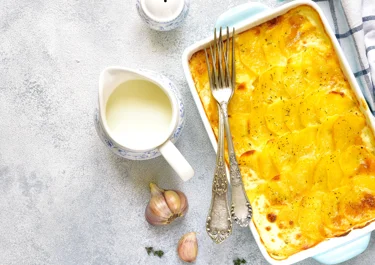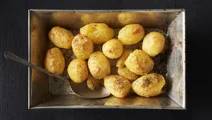Scalloped Potatoes

This recipe for scalloped potatoes keeps things easy. A few simple ingredients, a bit of slicing, and the oven takes care of the rest. Once it is in, there is nothing left to do but wait. Thin layers of potato soak up spiced double cream, turning soft and rich under a golden, crispy top. A hands-off side that catches the eye and never lasts long at the table.
Ingredients
|
2¼ kilo
Potatoes
|
|
|---|---|
|
4½ tsp
Sea salt
|
|
|
1 tsp
Grated nutmeg
|
|
|
1 pinch
Freshly pepper
|
|
|
250 ml
Double cream
|
|
|
25 g
Butter (for greasing)
|
Instructions
Recommended information
Serving suggestion
Bring out the mandoline for the potatoes
A mandoline slicer is the easiest way to cut thin, even slices and helps the potatoes cook at the same rate. Most mandolines have an adjustable setting, so set it to 3 mm. Thicker slices take longer to soften; uneven ones can leave some overcooked while others stay firm. If you do not have a mandoline, use a sharp knife and aim for the same thickness in every slice.
Avoid discolouration of potatoes
Potato slices can turn brown when exposed to air. Submerging them in a bowl of cold water immediately after slicing helps keep their colour. Let them stay in the water until you can layer them in the baking dish. Before layering, drain them well, and pat dry with a clean kitchen towel or paper towel to remove excess moisture. Too much water trapped between the layers can create steam in the oven, making the potatoes turn watery instead of baking into a creamy, structured texture. Do not prepare them too far in advance. Even in water, potatoes can start to lose their freshness over time. It is best to slice them close to when you plan to bake them.
Prevent overflow in the oven
The cream can bubble over while baking, creating spills that burn onto the oven floor. Place a baking sheet lined with aluminium foil under the dish to avoid this. The baking sheet catches any drips, keeps the oven clean, and prevents smoke from burnt spills.
Questions about scalloped potatoes
Are you making scalloped potatoes for the first time or just running into a few questions? We answer the most important ones below.
What type of potatoes are best for making scalloped potatoes?
Floury potatoes work best for scalloped potatoes, as they soften during baking, and their starch helps create a creamy texture. Maris Piper and King Edward are both good choices. Maris Piper, with its higher starch content, thickens the cream more and gives the layers a smooth, tender consistency. King Edward is also floury but holds its shape a little better while still turning soft, though the sauce will not be as thick. For the creamiest result, Maris Piper is the best choice. If you prefer slightly more structure, go for King Edward.
Can you prepare scalloped potatoes in advance?
Yes, scalloped potatoes can be made ahead of time. Bake them as usual, then let them cool to room temperature before covering and refrigerating. They can be stored in the fridge for up to 3 days. When ready to serve, reheat in the oven at 175 °C for about 30 minutes or until heated through. If you need to keep them warm while waiting for other sides, cover them with aluminium foil and lower the oven temperature to 120 °C, since this keeps them hot without overcooking.
What is the difference between scalloped potatoes and potatoes au gratin?
The main difference between scalloped potatoes and potatoes au gratin is the use of cheese. Scalloped potatoes are made with a cream or milk-based sauce and usually do not contain cheese, while potatoes au gratin have cheese layered between the potatoes or sprinkled on top. This gives scalloped potatoes a smooth, creamy texture, while potatoes au gratin have a richer taste and a slightly firmer texture due to the melted cheese.
How do I store and reheat scalloped potatoes?
Let the scalloped potatoes cool to room temperature after baking. Then, cover the dish tightly with aluminium foil or transfer the potatoes to an airtight container before refrigerating. They can be kept in the fridge for 3 days. When you are looking to reheat the meal, preheat the oven to 175 °C. If keeping the potatoes in the original baking dish, cover it with aluminium foil to prevent them from drying out. Heat for about 30 minutes or until warmed through. If you are reheating a smaller portion in the microwave, transfer it to a microwave-safe container, cover loosely, and heat in 30-second intervals. Stir between each interval to distribute the heat evenly and continue until the potatoes are hot throughout.
Can I parboil the potatoes to reduce the baking time?
Yes, parboiling the potatoes for about 8 minutes before baking can shorten the cooking time. After parboiling, drain and dry the potatoes thoroughly to prevent excess moisture, which could affect the texture. Once dried, layer them in the dish and bake as usual. This helps speed up the process while still allowing the top to turn golden and crisp.
How can I ensure the potatoes cook evenly in the casserole?
Use a shallow dish if you want to cook the potatoes evenly. The heat will reach all layers more evenly, preventing the top from browning too quickly while the lower layers remain firm. A deeper dish can lead to uneven cooking, with some slices turning too soft while others remain undercooked. Spreading the potatoes in a shallow layer helps them cook simultaneously, resulting in a consistent texture throughout.
Make deliciously creamy scalloped potatoes
Potatoes have a way of taking on all sorts of roles, turning into crispy chips, buttery mash, or fluffy roasties. In this recipe, they take on the role of the beloved scalloped potatoes that are known for their soft, rich, and irresistibly smooth texture.
Thin slices of potato soak up the cream as they cook, turning melt-in-the-mouth tender. The cream thickens as it bakes, creating a silky coating around every slice of potato, no exception. No boiling, no fuss, just a simple bake that lets the potatoes do what they do best, turning creamy, luscious, and impossible to resist.
Nutty and slightly sweet nutmeg flavours
Nutmeg is the perfect partner for creamy potatoes, thanks to its warm, slightly sweet flavour that complements their earthy taste. When freshly grated, it brings out a woody aroma with a hint of warmth that melds effortlessly with the potatoes' soft, comforting notes. Its subtle spice cuts through the creaminess, keeping the nuances balanced and intriguing without stealing the spotlight.
With its well-known crispy and golden-brown top
Are you familiar with the signature crisp, golden-brown crown of scalloped potatoes? Well, you will be soon enough. The top forms as the cream thickens and the edges of the potatoes caramelise. Beneath that beautifully baked surface, the layers turn rich and tender, soaking up the velvety sauce. The contrast between the crispy top and the creamy potatoes underneath is what makes this a favourite on any table, for kids and adults alike.
A cosy side made with 5 ingredients
Five ingredients are all you need to have on hand for scalloped potatoes, a comfort food wonder. Just potatoes, cream, salt, pepper, and a pinch of nutmeg bake together slowly in the oven, turning tender and full of flavour as they soak up the sauce.
Find a few partners for the potatoes and transform this simple side into a full-on feast. Serve them with roasted chicken or beef, letting the potatoes catch all those meaty juices. Add a crisp green salad or steamed vegetables to lighten things up. Whatever is on the table, just beware that scalloped potatoes always have a way of disappearing first.
Other easy sides worth trying include our dauphinoise potatoes with their soft, cheesy centre, tarragon sauce for something rich and aromatic, and pickled cucumbers for when you need something sharp and easy.
Take the recipe in new directions
This recipe keeps things classic, but a few extra tweaks can give scalloped potatoes even more character. Herbs and spices bring freshness and warmth, making each bite more interesting.
For a herby touch, fresh thyme sneaks in a light earthiness with a hint of lemon, keeping the creamy sauce from feeling too heavy. Rosemary is also a viable option with its bold, pine-like aroma, adding a more robust flavour that stands up to the hearty potatoes.
A bit of warmth comes naturally with garlic powder. It works its magic in the background, adding mellow sweetness and depth. Unlike fresh garlic, which can be pungent, garlic powder blends seamlessly into the cream. Smoked paprika turns up with a touch of sweetness and smokiness, giving the potatoes another layer of depth.









